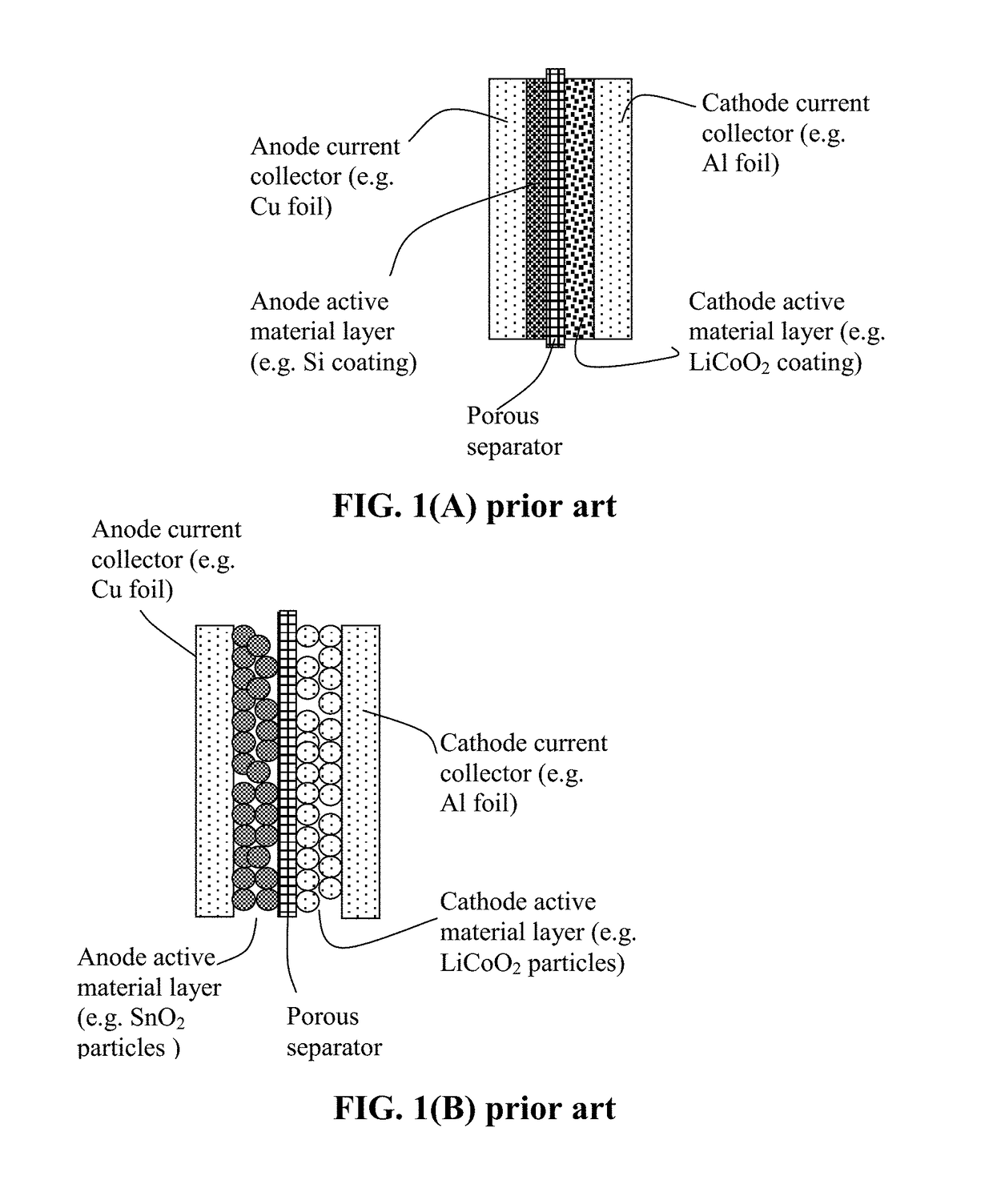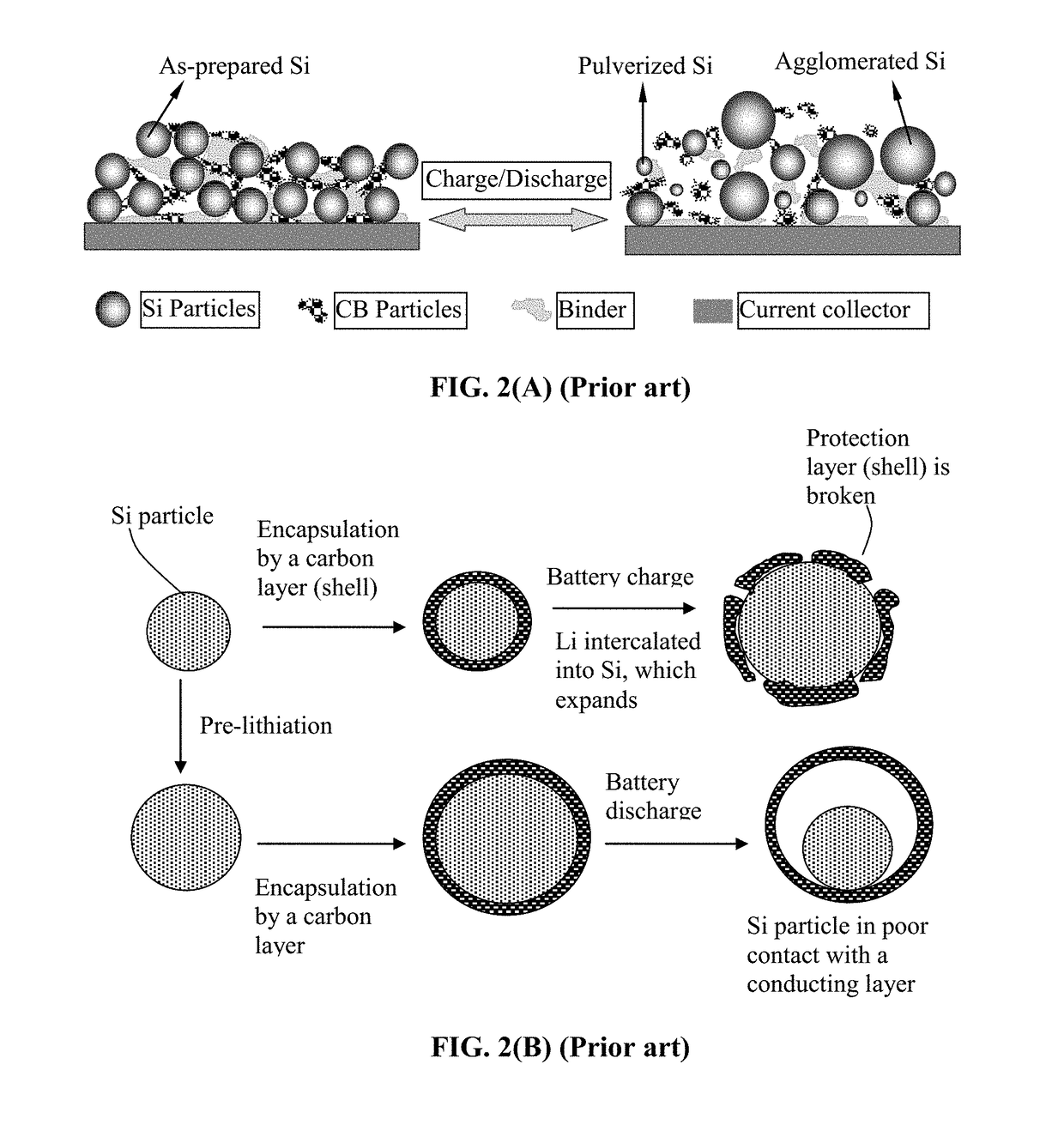Protected Particles of Anode Active Materials, Lithium Secondary Batteries Containing Same and Method of Manufacturing
a technology of lithium secondary batteries and active materials, which is applied in the direction of secondary cell servicing/maintenance, sustainable manufacturing/processing, cell components, etc., can solve the problems of severe pulverization (fragmentation of alloy particles), and loss of contacts between active material particles and conductive additives, etc., to achieve high lithium-ion conductivity, high elasticity, and high elastic deformation strain
- Summary
- Abstract
- Description
- Claims
- Application Information
AI Technical Summary
Benefits of technology
Problems solved by technology
Method used
Image
Examples
example 2
ticity Polymer-Encapsulated Tin Oxide Particulates
[0130]Tin oxide (SnO2) nanoparticles were obtained by the controlled hydrolysis of SnCl4.5H2O with NaOH using the following procedure: SnCl4.5H2O (0.95 g, 2.7 m-mol) and NaOH (0.212 g, 5.3 m-mol) were dissolved in 50 mL of distilled water each. The NaOH solution was added drop-wise under vigorous stirring to the tin chloride solution at a rate of 1 mL / min. This solution was homogenized by sonication for 5 m in. Subsequently, the resulting hydrosol was reacted with H2SO4. To this mixed solution, few drops of 0.1 M of H2SO4 were added to flocculate the product. The precipitated solid was collected by centrifugation, washed with water and ethanol, and dried in vacuum. The dried product (SnO2) was heat-treated at 400° C. for 2 h under Ar atmosphere. In a separate experiment, graphene oxide was added to the reactor containing SnCl4.5H2O and NaOH. Other procedures remain the same and the resulting products were graphene-wrapped SnO2 partic...
example 3
Nanoparticles Encapsulated by Another Polyrotaxane-Based High-Elasticity Polymer
[0136]This polyrotaxane (PR) consists of a-cyclodextrin (a-CD), polyethylene glycol (PEG) with terminal carboxylic acids and a capping agent (1-adamantanamine). In the slide-ring gel, α-CDs in one PR are cross-linked to α-CDs in different PRs. The PEG main chains are not fixed at the cross-linking points in the polymer network; instead, they can pass through the hole of a figure-of-eight-shaped junction of cross-linked α-CDs freely, which is called the ‘pulley effect’. The stress exerted on part of the polymer network is minimized through this effect. As a result, the polymer network exhibits high extensibility and a small hysteresis on repeated extension and contraction.
[0137]Polymer networks using PR as a cross-linker and N-Isopropylacrylamide (NIPA) as the monomer were prepared. In addition, ionic sites were introduced into the PR-cross-linked polymer network to obtain extremely high-elasticity polyme...
example 4
re-Based Particulates Protected by a High-Elasticity Polymer
[0144]Si nanoparticles and Si nanowires Si nanoparticles are available from Angstron Energy Co. (Dayton, Ohio). Si nanowires, mixtures of Si and carbon, and their graphene sheets-embraced versions were then further embraced with the polyrotaxane network as described in Example 1).
[0145]The air-suspension coating method was used to encapsulate anode active material particles into core-shell structures. Some Si nanowires were coated with a layer of amorphous carbon and then encapsulated with the polymer network. For comparison purposes, Si nanowires unprotected and those protected by carbon coating (but no polymer encapsulation), respectively, were also prepared and implemented in a separate lithium-ion cell. In all four cells, approximately 25-30% of graphite particles were mixed with the protected or unprotected Si nanowires (SiNW), along with 5% binder resin, to make an anode electrode. The cycling behaviors of these 4 cel...
PUM
| Property | Measurement | Unit |
|---|---|---|
| Length | aaaaa | aaaaa |
| Fraction | aaaaa | aaaaa |
| Fraction | aaaaa | aaaaa |
Abstract
Description
Claims
Application Information
 Login to View More
Login to View More - R&D
- Intellectual Property
- Life Sciences
- Materials
- Tech Scout
- Unparalleled Data Quality
- Higher Quality Content
- 60% Fewer Hallucinations
Browse by: Latest US Patents, China's latest patents, Technical Efficacy Thesaurus, Application Domain, Technology Topic, Popular Technical Reports.
© 2025 PatSnap. All rights reserved.Legal|Privacy policy|Modern Slavery Act Transparency Statement|Sitemap|About US| Contact US: help@patsnap.com



